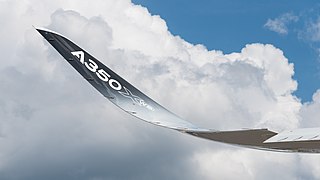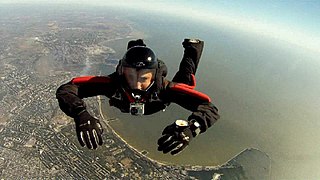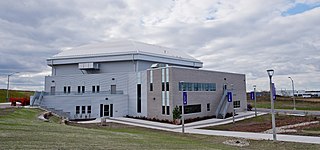Related Research Articles

Wind tunnels are large tubes with air blowing through them which are used to replicate the interaction between air and an object flying through the air or moving along the ground. Researchers use wind tunnels to learn more about how an aircraft will fly. NASA uses wind tunnels to test scale models of aircraft and spacecraft. Some wind tunnels are large enough to contain full-size versions of vehicles. The wind tunnel moves air around an object, making it seem as if the object is flying.

The Ames Research Center (ARC), also known as NASA Ames, is a major NASA research center at Moffett Federal Airfield in California's Silicon Valley. It was founded in 1939 as the second National Advisory Committee for Aeronautics (NACA) laboratory. That agency was dissolved and its assets and personnel transferred to the newly created National Aeronautics and Space Administration (NASA) on October 1, 1958. NASA Ames is named in honor of Joseph Sweetman Ames, a physicist and one of the founding members of NACA. At last estimate NASA Ames had over US$3 billion in capital equipment, 2,300 research personnel and a US$860 million annual budget.

The history of aviation extends for more than two thousand years, from the earliest forms of aviation such as kites and attempts at tower jumping to supersonic and hypersonic flight by powered, heavier-than-air jets.

The National Advisory Committee for Aeronautics (NACA) was a United States federal agency founded on March 3, 1915, to undertake, promote, and institutionalize aeronautical research. On October 1, 1958, the agency was dissolved and its assets and personnel were transferred to the newly created National Aeronautics and Space Administration (NASA). NACA is an initialism, i.e., pronounced as individual letters, rather than as a whole word.

Wingtip devices are intended to improve the efficiency of fixed-wing aircraft by reducing drag. Although there are several types of wing tip devices which function in different manners, their intended effect is always to reduce an aircraft's drag by partial recovery of the tip vortex energy. Wingtip devices can also improve aircraft handling characteristics and enhance safety for following aircraft. Such devices increase the effective aspect ratio of a wing without greatly increasing the wingspan. Extending the span would lower lift-induced drag, but would increase parasitic drag and would require boosting the strength and weight of the wing. At some point, there is no net benefit from further increased span. There may also be operational considerations that limit the allowable wingspan.
In common usage, wind gradient, more specifically wind speed gradient or wind velocity gradient, or alternatively shear wind, is the vertical component of the gradient of the mean horizontal wind speed in the lower atmosphere. It is the rate of increase of wind strength with unit increase in height above ground level. In metric units, it is often measured in units of meters per second of speed, per kilometer of height (m/s/km), which reduces to the standard unit of shear rate, inverse seconds (s−1).

Wingsuit flying is the sport of skydiving using a webbing-sleeved jumpsuit called a wingsuit to add webbed area to the diver's body and generate increased lift, which allows extended air time by gliding flight rather than just free falling. The modern wingsuit, first developed in the late 1990s, uses a pair of fabric membranes stretched flat between the arms and flanks/thighs to imitate an airfoil, and often also between the legs to function as a tail and allow some aerial steering.

In meteorology, the planetary boundary layer (PBL), also known as the atmospheric boundary layer (ABL) or peplosphere, is the lowest part of the atmosphere and its behaviour is directly influenced by its contact with a planetary surface. On Earth it usually responds to changes in surface radiative forcing in an hour or less. In this layer physical quantities such as flow velocity, temperature, and moisture display rapid fluctuations (turbulence) and vertical mixing is strong. Above the PBL is the "free atmosphere", where the wind is approximately geostrophic, while within the PBL the wind is affected by surface drag and turns across the isobars.

Early flying machines include all forms of aircraft studied or constructed before the development of the modern aeroplane by 1910. The story of modern flight begins more than a century before the first successful manned aeroplane, and the earliest aircraft thousands of years before.
ICAD is a knowledge-based engineering (KBE) system that enables users to encode design knowledge using a semantic representation that can be evaluated for Parasolid output. ICAD has an open architecture that can utilize all the power and flexibility of the underlying language.
The Closing Ceremony of the 2006 Winter Olympics took place on 26 February 2006 beginning at 20:00 CET (UTC+1) at the Stadio Olimpico in Turin, Italy.

A vertical wind tunnel (VWT) is a wind tunnel that moves air up in a vertical column. Unlike standard wind tunnels, which have test sections that are oriented horizontally, as experienced in level flight, a vertical orientation enables gravity to be countered by drag instead of lift, as experienced in an aircraft spin or by a skydiver at terminal velocity.

The Bell XV-3 is an American tiltrotor aircraft developed by Bell Helicopter for a joint research program between the United States Air Force and the United States Army in order to explore convertiplane technologies. The XV-3 featured an engine mounted in the fuselage with driveshafts transferring power to two-bladed rotor assemblies mounted on the wingtips. The wingtip rotor assemblies were mounted to tilt 90 degrees from vertical to horizontal, designed to allow the XV-3 to take off and land like a helicopter but fly at faster airspeeds, similar to a conventional fixed-wing aircraft.

A personal air vehicle (PAV) is a proposed type of aircraft providing on-demand aviation services.

Jon Anders Olsson Delér is a professional freeskier and alpine ski racer from Sweden. Born in Mora, Olsson Delér started his career as a ski racer but at age 16 he switched his race skis for twin tips and quit ski racing. Eight years later, after a 50 000 SEK (US$5826.22) bet with fellow skier Jens Byggmark, Olsson Delér started ski racing again with the goal of the bets being to make it to the Olympics in 2014. He now competes in both freestyle and ski racing. Olsson Delér is known for his invention of several new double flips, including a D-spin 720 into a flatspin 540, a switch double rodeo 1080, a double flatspin 900, and a switch cork 720 to flatspin 540.

The MBB Lampyridae was a low-observable medium missile fighter (MRMF) developed during the 1980s by the West German aerospace company Messerschmitt-Bölkow-Blohm (MBB). The programme was terminated during 1987 without any production aircraft having been produced.

Parachuting, including also skydiving, is a method of transiting from a high point in the atmosphere to the surface of Earth with the aid of gravity, involving the control of speed during the descent using a parachute or parachutes.

Aerodium is a designer and producer of vertical wind tunnels based in Riga, Latvia. Its core business is related to sales and rent of wind tunnels for entertainment and military industries, but it also operates different locations under franchise. A second part is connected to organizing shows and performances for brand promotion, festivals and other celebrations around the world.

The Wind Engineering, Energy and Environment (WindEEE) Dome is a hexagonal-shaped vertical wind tunnel proposed for the University of Western Ontario. It is designed to simulate localized, high-intensity wind patterns such as downbursts and tornadoes that have never been studied before.
Shearwater Research is a Canadian manufacturer of dive computers and rebreather electronics for technical diving.
References
- ↑ Ivars Beitāns: Man tauriņi vēderā ir joprojām
- ↑ Zināmi konkursa „Siguldas novada gada cilvēks 2005” laureāti
- ↑ "Login • Instagram". Archived from the original on 2021-12-26.
{{cite web}}: Cite uses generic title (help) - ↑ "Open-air vertical wind tunnel model O2 - Aerodium". Aerodium.
- ↑ All New O2 Open Wind Tunnel by AERODIUM
- ↑ "Login • Instagram". Archived from the original on 2021-12-26.
{{cite web}}: Cite uses generic title (help)